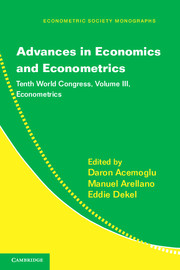Book contents
- Frontmatter
- Contents
- Contributors
- Preface
- I ECONOMETRICS OF INDUSTRIAL ORGANIZATION
- II MACROECONOMETRICS
- 4 Macroeconomics and Volatility: Data, Models, and Estimation
- 5 Estimation and Evaluation of DSGE Models: Progress and Challenges
- 6 Discussion of Fernández-Villaverde and Rubio-Ramírez as well as Schorfheide
- III ECONOMETRIC THEORY
- IV EMPIRICAL MICROECONOMICS
- V TIME SERIES AND PANELS
- VI MIRRLEES REVIEW: RETHINKING THE TAX SYSTEM FOR THE TWENTY-FIRST CENTURY
- Name Index
- Miscellaneous Endmatter
5 - Estimation and Evaluation of DSGE Models: Progress and Challenges
Published online by Cambridge University Press: 05 May 2013
- Frontmatter
- Contents
- Contributors
- Preface
- I ECONOMETRICS OF INDUSTRIAL ORGANIZATION
- II MACROECONOMETRICS
- 4 Macroeconomics and Volatility: Data, Models, and Estimation
- 5 Estimation and Evaluation of DSGE Models: Progress and Challenges
- 6 Discussion of Fernández-Villaverde and Rubio-Ramírez as well as Schorfheide
- III ECONOMETRIC THEORY
- IV EMPIRICAL MICROECONOMICS
- V TIME SERIES AND PANELS
- VI MIRRLEES REVIEW: RETHINKING THE TAX SYSTEM FOR THE TWENTY-FIRST CENTURY
- Name Index
- Miscellaneous Endmatter
Summary
Introduction
Estimated Dynamic Stochastic General Equilibrium (DSGE) models are now widely used for empirical research in macroeconomics as well as quantitative policy analysis and forecasting at central banks around the world. This chapter summarizes recent advances in the econometric analysis of DSGE models, discusses current challenges, and highlights avenues for future research. To illustrate the advances of the past decade, a prototypical empirical analysis based on a small-scale New-Keynesian DSGE model is presented. In this application, Bayesian inference is used to measure the welfare effect of changing the central bank's target inflation rate. The Bayesian inference is implemented through Markov Chain Monte Carlo (MCMC) methods, which deliver draws from the posterior distribution of DSGE-model parameters. These draws canbe converted into impulse-response functions (IRFs), welfare effects of policy changes, or other quantities of interest. Moreover, it is straightforward to obtain point estimates (e.g., posterior means or medians) or credible sets that reflect the posterior uncertainty.
Despite the advances of the DSGE-model literature, many important challenges remain; this chapter considers five in detail. First, whereas reported credible (or confidence) sets for DSGE-model parameters are often narrow, from a meta perspective, estimates of many important parameters tend to be fragile across empirical studies. Second, macroeconomic fluctuations in DSGE models are generated by exogenous disturbances. The estimated shock processes are often highly persistent, and their path closely mirrors the path of one of the observables. This raises concerns as to whether these shocks capture aggregate uncertainty or misspecification.
- Type
- Chapter
- Information
- Advances in Economics and EconometricsTenth World Congress, pp. 184 - 230Publisher: Cambridge University PressPrint publication year: 2013
- 21
- Cited by



